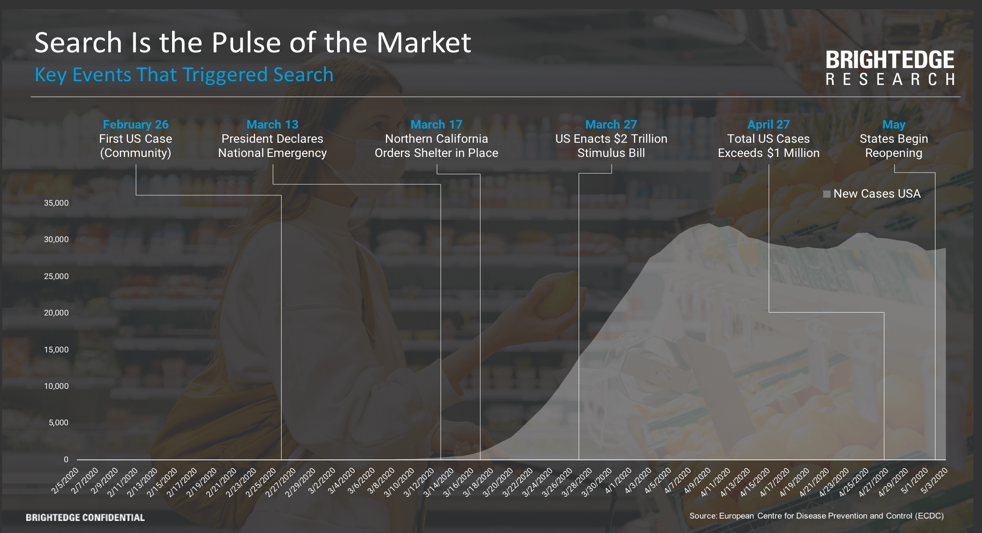Seasonal shopping trends can drive revenues up.
But how high?
The answer lies in how your organization is leveraging the power of macro (market insights) and micro (historical trends and real-time insights).
Furthermore, using this data-driven approach allows marketers to model search intent at every point of the customer journey and across multiple channels.
With COVID-19 shifting enormous swathes of retail shoppers online to fulfill their needs, there is no better time to utilize market insights to understand consumer and market behavior and search insights to drive search and digital marketing.
As always, dynamically optimized content is critical.
Before You Create, Understand
A large portion of B2B content is not engaged with.
You can’t merely start churning out content to meet heightened demand from new revenue sources.
Before you even brainstorm a topic list, look to search demand to see where historical trends fell over the past four years, and compare that to real-time trends and predictions in the current moment.
Priorities have changed for millions of Americans. What worked 12 months ago may not work now.
To stay relevant and retain consumer attention, you’ll need to adapt your approach.
Understand the market and the consumer before you begin your search campaigns.
How can you show value in the current climate?
Dig deep into trends and topics and categories to discover where you’d be best served by prioritizing.
Note what content should be optimized, and then which keywords to focus on.
Revisit competitor research from past years and engage in new research for newcomers to your niche to ensure you maintain your share of voice (SOV) and share of market.
What Categories Are Driving Current Performance?
Retailers focused on necessities saw a sharp uptime in Q1.
Luxury purchases slid, as big purchases were postponed.
Where does your industry intersect with rises in demand?
Look at high performing assets and find ways to capitalize further.
Where Are the Best New Opportunities?
If your company is financially stable, now might be the time to take small risks and experiment.
Consumers are realizing their need for things that don’t even exist, so funnel extra budget into R&D.
It’s the perfect time to innovate for new types of consumers and deliver innovative experiences that can perform on multiple channels.
What Areas Have the Most Significant Opportunities
Some things may “go back to normal” post-pandemic.
Other changes may be here to stay.
A workforce and a learning generation went remote at the drop of a hat, and the “new normal” may provide for greater flexibility in day-to-day lives than ever before.
How can you serve a more independent, more isolated (and in some cases, increasingly local) audience?
What Areas Have a Smaller Opportunity But Higher Gain
Highly specific targeting can reveal opportunities for entry into incredibly niche markets.
Efforts may increase slightly but can more than be made up for in through higher returns.
As shipping and logistics companies struggle to meet consumer demand, alternatives are sought after.
Positioning a product or service as an acceptable substitute for a well-known brand could provide unique opportunities, as can finding seasonal holes in need of filling.
What Has Long Term vs. Short Term Potential?
This, too, shall pass is the mantra nearly everyone is chanting to themselves.
Track real-time opportunities for short term investment, but don’t forget to plan for long-term results as well – especially with extended holiday seasons almost upon us.
Delivery services are hot at the moment, but will the expense eventually tarnish the shine for consumers?
Find ways to serve those who are eager to step into the upcoming year with a (hopefully) brighter outlook.
Digital & Search Are Ever-Expanding
An ever-expanding portion of a buyer’s journey is now centered online.
Even if a consumer visits a brick-and-mortar location to finalize their purchase, the early stages of the customer funnel are almost exclusively digital.
Being able to define intent and follow up with targeted and pre-optimized content to support or convert that intent will be what makes your company stand out.
The most impressive advances Google has made over the past few decades are in regard to the search engine’s ability to understand user intent.
What started as simple keyword matching has expanded to competency in factoring phrases, search history, location data, and other query elements to get in the heads of users.
The search ranking algorithm has evolved beyond merely ranking websites by their compliance with on and offsite SEO.
Now, the typical user’s experience is informed by data that uncovers what they really want, regardless of how they ask.
The emergence of Google’s intent-recognition methodology allows marketers to identify and position themselves to take advantage of crucial moments in each customer’s journey by tapping into their thought process at any given moment.
This allows you to create content that takes advantage of the intent in real-time.
What Do Consumers Really Want?
Develop customer intent profiles by analyzing three user-side data flows.
- Range of terms searched.
- Range of behaviors exhibited.
- Range of answer-types sought.
Google sees an individual user’s data points along with these flows as “micro-moments.”
These points in time correlate with the best opportunity to sway a user with targeted search results.
There is an excellent opportunity for marketers to take this further by utilizing machine learning and automation to create intent-based, dynamic, and relevant content in real-time.
After all, consumers now demand instant responses that serve their needs while giving them a unique and informative experience along their buying journey.
Knowledge-Based Results
These queries signal a consumer’s intent to learn.
Their search queries are typically questions and start with:
- “How” (How do spark plugs work?)
- “What” (What do I need to make eggs Benedict?)
- “Why” (Why does my dog tear up my house when I leave?)
These users can be targeted at their point of intent with high-value, informative content that gives them precisely the information they need.
A subtle nudge to sell a product or service (replacement auto part, egg poaching tool, dog-walking service) can be neatly contained in the content.
Location-Based Results
These queries signal a consumer’s intent to travel, whether it’s to a location across town, in another state, or on another continent.
They often start with hospitality words like “restaurant” (best restaurant within 10 miles), or “hotel” (hotel near O’Hare airport.)
They may also use terms like “route” (route to Lake Tahoe) or “flights” (flights to Reykjavik.)
These users can be targeted at their point of intent with straightforward, actionable content that:
- Delivers options.
- Shares a call to action (i.e., visit this restaurant near you, book a flight/hotel room, buy a travel pillow).
Action-Oriented Results
These queries signal a consumer’s intent to act.
Like some knowledge-based searches, action-oriented queries start with “how” but expand to methodology, asking:
- “How do I” (How do I build a doghouse?).
- “How to” (How to clean wine stains out of carpet).
These users can be targeted at their point of intent with information bundled with offers to facilitate their action or even act for them (downloadable dog house plans, affordable carpet cleaning services.)
Purchase-Oriented Results
These queries signal a consumer’s intent to buy.
They’ve done their research, absorbed the information, and are interested in offers.
Their queries have highly specific keyword strings targeted to their goals such as:
- “2 liter blender all metal gears under $200” (as opposed to merely “blenders”
- “Aspen hotel deal ski resort”
These users can be targeted at their point of intent with heavily targeted sales copy that points them squarely at a button that says “BUY NOW”, “BOOK NOW”, or “GET THIS DEAL.”
Consumers at this stage of the customer journey have their details ready to input and their credit card in their hand.
Modeling Intent
Google is now capable of identifying and assigning intent to queries and instantly serving up results driven by increasingly complex algorithms.
Brands must be ready to move content production into high gear, while marketers require intelligent data to create and optimize the content to motivate consumers at every moment possible.
The most effective and reliable way to achieve this goal is by modeling intent.
Use AIs to track consumer behaviors and parallel Google’s approach.
Leverage market insights to reveal moment by moment changes in wants, needs, and desires of a population virtually in stasis.
Seasonal shopping used to be predictable, but this year, buyers’ habits are anyone’s choice.
Only by identifying, tracking, and anticipating intent will marketers be able to stay in the game.
Research at BrightEdge has shown (below) that – just like marketers did with COVID and Consumer Behavior – marketers need to look at macro market trends and key triggers that impact audience behavior. (Disclosure: I am Co-founder and CTO at BrightEdge.)

Harnessing the Power of Intent Through Content
Content and SEO strategy has never been more important than it is right now.
Minute to minute changes across the globe cause shifts in consumers’ states of mind, feelings of security or insecurity, and ability to think past the next day, week, or month.
Marketers can assess current content against the real-time landscape to:
- Gauge how consumers will behave seasonally in contrast to past years.
- Then create a plan to cover gaps and take advantage of new opportunities.
COVID-19 may have caused a switch in the tracks, but the wheels are still turning, affording plenty of opportunities.
Most of all, leverage intent.
Machine learning has made it possible to clean, sort, and segment vast datasets practically in real-time, and intent is one area of consumer behavior ripe for application.
Finding patterns allows for predictive analysis, leading to timely positioning to take advantage of intent.
The result is a newly empowered ability to turn insights into content into results.
- Insights and content creation: Content can be tailored based on consumer intent.
- Insights and SEO: Keyword research can reveal new opportunities and markets.
- Insights and PPC: Competitor research can showcase overlooked opportunities.
- Insights and web development: Site-hosted tools can generate goodwill.
- Insights and mobile: Apps and gamification can prompt consumers down the funnel.
Content needs must be mapped to the customer journey, with specific emphasis on macro and micro-moments and intent.
The goal is more attraction, more engagement, and more conversions.
Each new piece of content should match a level of interest that makes it a worthwhile investment.
Evergreen content may no longer be evergreen but check before you select new topics to ensure your subject is sufficiently different from existing content to command its own real estate.
Make sure your topics have strong relevance to your business, and that they can be connected with a solution in the form of a product or service.
Finally, ensure your SEO joins forces with machine learning to provide your company with access to data that can be parsed for intent.
Machine learning is already helping to power automated insights and drive “next best actions.”
When you understand both market and consumer intent and execute correctly, you then hold the keys to unlimited opportunity.
More Resources:
- Ecommerce Marketing: The Definitive Guide
- SEO Seasonality: Overcoming the Dips During the Slow Season
- How to Leverage Seasonal Content for SEO Campaigns
Image Credits
In-Post Image: BrightEdge





